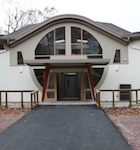At a Glance
Location
Plano, TX
Founded
1946
Employees
1,250
Specialty
Manufacturing air-distribution products
Annual Sales
$130 million
The primary function of HVAC systems has always been to maximize occupant comfort, which seems at first like an easy enough task. Units keep spaces warm in winter and cool in the summer, and as long as the air pumping in is fresh, theoretically, there should be nothing to complain about. However, leading air-distribution firm Titus humbly suggests there’s more to consider.
“We’ve always been proponents of comfort, working to achieve an appropriate air-distribution performance index [ADPI]” director of marketing Rob Copeland says. “But with creatively designed buildings, often with many more windows that make good use of natural lighting, we have to move air around in different ways.” He also says every room in every building is different, and when you factor in seasonal temperatures and the extremes found at different latitudes—plus the fact that warm air naturally rises—HVAC design becomes downright complicated.
But it’s also exciting. Working from a 20,000-square-foot R & D facility, Titus engineers are using newer technologies to revolutionize the ways that indoor air is distributed. And, among the tools they have developed are adjustable air-pattern controllers that direct cold and warm drafts in different directions.
Top 4 Air-Distribution Innovations from Titus
1. The EOS perimeter slot diffuser eliminates wasteful, ineffectual horizontal or vertical air discharge by switching between heating and cooling modes.
2. Various architectural finishes—about 47 different wood-grain and stone veneers—can be applied to vents, offering broader interior design options.
3. The Solar Plexicon is a displacement ventilation system that heats and cools without a secondary heating system, using wireless solar energy as its power source.
4. The Alpha Controller is preconfigured at the factory to save time and money, and it can be commissioned through a thermostat, eliminating the need for software at the job site.
Titus’ modern, sophisticated displacement ventilation systems are able to spread cool air across a floor in a such a way that the air’s natural buoyancy builds a stratification of minor temperature differences up to the ceiling. Compared with traditional ceiling-level systems that blow cool air directly over or across major lighting fixtures, warming it before it ever reaches the people sitting or standing in the room, Titus’s designs achieve comfort more efficiently, and this results in significant energy savings.
“We work with a couple of major hotel chains,” vice president of sales and marketing Keith Glasch says. “One company wants to reduce energy use by 30 percent by the year 2020. In buildings where we have installed smart-control valves and energy-efficient motors, we have already achieved a 40 percent energy-efficiency improvement.” These smart controls—products Titus often incorporates into its systems—respond to guest arrivals and departures in each room, maintaining different temperatures for occupancy and nonoccupancy. And some smart controls can even recognize the difference between paying guests and hotel employees, based on the type of door key used to enter the room.
Titus’s air distribution diffusers are built with responsive, movable parts that require a power source, but the company hasn’t let this hinder its energy-efficiency goals either. Rather than connecting them to the electrical system—and adding to construction and energy costs—the company powers its systems by ambient light energy, both solar and artificial.
Because of such innovation, architects and engineers eager to learn about new air-distribution approaches often do so through Titus University’s online webinars and multiday workshops, held at the company’s Plano, Texas, headquarters. And Titus continues to be a leader in product development, as evidenced by its continuing series of YouTube clips, in which the efficiency of its latest technologies is made visual through the use of theatrical smoke.
“Our goal is the net-zero-energy building,” Glasch says. “We can do this by extending the application of energy harvesting and wireless technology.” Titus researchers are now studying ways to capture the energy of human body heat, a capability that would allow the company to effectively draw power from the very people it serves through smarter air distribution. If the company succeeds, it will close the energy loop in a beautifully simple way. ABQ


